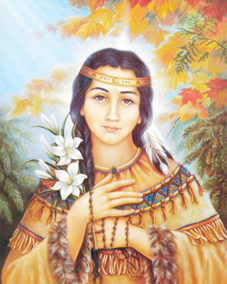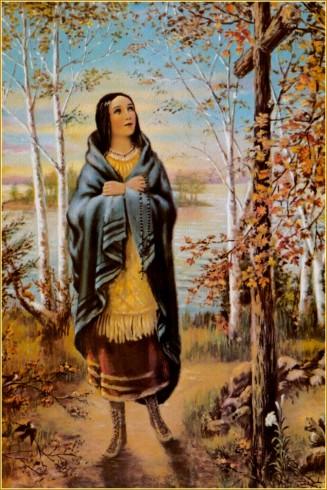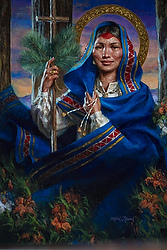
Summary: St Kateri. Many Catholics outside of the USA will not have heard of this young Native American girl, Bl Kateri Tekakwitha (Teck-ak-with-a), who lived in the 17th Century. She was born in 1656, at Fonda, upstate New York. Her mother was a Catholic Algonquin (Huron) and her father a Mohawk chief.
Fr Patrick McCafferty sent us this biography of Saint Kateri Tekakwitha.
 When Kateri was four years old, smallpox infected her village killing many, including her parents and baby brother. She was orphaned and taken in by relatives who were hostile to the Christian faith being taught by the ‘Blackrobes‘, i.e. Jesuit missionaries, a number of whom had been martyred by the Indians.
When Kateri was four years old, smallpox infected her village killing many, including her parents and baby brother. She was orphaned and taken in by relatives who were hostile to the Christian faith being taught by the ‘Blackrobes‘, i.e. Jesuit missionaries, a number of whom had been martyred by the Indians.
Martyrs for the Faith
A short distance from Blessed Kateri’s birthplace, at Auriesville, NY, St Isaac Jogues (a Jesuit priest), St René Goupil and St Jean de la Lande (two young catechists) were tomahawked to death, in 1646, for their efforts at evangelisation among the Iroquois tribes. St Isaac Jogues had, a few years previously, been held in captivity and brutally tortured. He was rescued by Dutch traders and taken back home to Belgium. As soon as his wounds were healed, he immediately went back to America, ‘to help my beloved savages’.
Also martyred during their missions to Native American tribes were St Antoine Daniel (1648), Ss Jean de Brébeuf, Noël Chabanel, Charles Garnier and Gabriel Lalmante (1649). It is poetically said that, from the ground moistened by the blood of these holy martyrs and intrepid missionaries, grew the fair flower, Kateri Tekakwitha, the Lily of the Mohawks.
Birth
She was born in 1656. Although her mother was a Catholic Huron (or Algonquin) Indian, Kateri had never been baptised (her father forbade it). She had, however, learnt to pray and her mother’s example of prayer had made a deep impression on her. She never forgot the Rosary her mother had taught her to pray. She would daily withdraw by herself to pray in the forest. She had a very special devotion to the Holy Mother of God. She has also been called ‘the Mystic of the Wilderness’.
Kateri barely survived the smallpox epidemic that killed her family. It left her weakened for the rest of her life and partially blind. Her Mohawk name, ‘Tekakwitha‘, means ‘she feels with her hands’. It has also been translated as ‘she bumps into things’ and ‘the one who puts things in order‘. Kateri had a great talent for quill and beadwork embroidery, despite her poor sight.
Becoming a Christian
Kateri longed and yearned for baptism, to become a Christian. This desire was not realised until she was twenty years old when her community was again visited by Jesuit missionaries. Kateri lived in an atmosphere that was distrustful of Christianity and the ‘strange ones’ who were arriving and intruding on the lives of her people as they had been lived for centuries. The arrival of the Western World in the ‘New World’ that would become the USA, would have tragic and devastating long-term consequences for all of the Native American Nations. Their wariness of the Christian Faith was understandable.
The Jesuit priests, however, sought to share their faith and love for the true God. Some would soon come to greatly respect the ‘Blackrobes‘. The missionaries won over many of the Indians by their courage and kindness. For example, the young Jesuit, St René Goupil, doctored and nursed the Mohawks who had tortured him, when they fell sick or got injured. The great Holy Man of the Lakota Sioux, Tatanka Yotanka (Sitting Bull), wore a Crucifix given to him by the Jesuit, Fr Pierre DeSmet, the great ‘apostle of the North West’.
Eventually, Kateri’s desire for baptism was realised at the age of 20. She chose the baptismal name of Kateri (Mohawk for Catherine). Her life, however, was made very unpleasant by those were still suspicious of the Christian faith. The Jesuit fathers feared for her safety and well being. In 1677, they persuaded her, after a particularly nasty incident (attempted rape), to go to Canada where there were villages of Christian Indians. She agreed after this traumatic event.
Her Spirit Grows
In four short years, Kateri Tekakwitha, accelerated towards the heights of great holiness of life. In the peace and safety of the Christian Indian villages, around Saulte Sainte Marie in Canada, the young woman, now having received her First Holy Communion, was drawn by the Lord into the depths of his love. She loved to spend time adoring Our Lord present in the Blessed Sacrament, even on the coldest of winter days in the unheated church.
 She was a most gentle and loving presence in the community. She was a great storyteller and people listened to her for hours. Her favourite subjects of discourse, of course, were Jesus and his mother. It is said that when she was praying, Blessed Kateri’s face became radiantly beautiful, ‘as if she was seeing the face of God’. Her great desire was to establish a religious order for Native American women but her poor health did not allow for this. She herself, however, was allowed to take the vows of a religious and consecrate herself to Christ. “Now, I belong to no one – only Jesus”, she said.
She was a most gentle and loving presence in the community. She was a great storyteller and people listened to her for hours. Her favourite subjects of discourse, of course, were Jesus and his mother. It is said that when she was praying, Blessed Kateri’s face became radiantly beautiful, ‘as if she was seeing the face of God’. Her great desire was to establish a religious order for Native American women but her poor health did not allow for this. She herself, however, was allowed to take the vows of a religious and consecrate herself to Christ. “Now, I belong to no one – only Jesus”, she said.
Death
Her poor health which had plagued her since the age of four was fast declining. She died in 1680, aged twenty-four. Immediately after her death, according to a number of witnesses, the smallpox scars that had covered her face for twenty years disappeared. She was declared ‘Venerable Servant of God‘ in 1943 and, during his Apostolic Visit to Canada in 1980, Bl Pope John Paul II inscribed her name among the Blessed – those seeing the face of God in heaven. Her memorial date is July 14th.
 ‘God ‘is wonderful in his saints’ (Ps 68:35). Everyone of them gives us a glimpse of the love and beauty of God ‘Who is the praise of all His saints’ (Ps 148:14). He raises up, everywhere and, ‘in every age, men and women (and children), outstanding in holiness, living witnesses of His unchanging Love. They inspire us by their heroic lives and help us by their constant prayers’ (Preface of the Mass for Holy Men and Women II).
‘God ‘is wonderful in his saints’ (Ps 68:35). Everyone of them gives us a glimpse of the love and beauty of God ‘Who is the praise of all His saints’ (Ps 148:14). He raises up, everywhere and, ‘in every age, men and women (and children), outstanding in holiness, living witnesses of His unchanging Love. They inspire us by their heroic lives and help us by their constant prayers’ (Preface of the Mass for Holy Men and Women II).
In the wilderness of North America, in primitive and difficult times, Blessed Kateri was a ‘sign of the Kingdom of Heaven’
Many look forward to the day of Blessed Kateri’s canonisation as a saint – an advocate, before God, for the traumatised native peoples of the USA, Canada, Australia and New Zealand: “Through her intercession, may all people of every nation be gathered into your Church to proclaim your greatness in one hymn of praise” (from the Opening Prayer of the Mass of Blessed Kateri Tekakwitha).Bl Kateri was canonized on 10/21/2012 by Pope Benedict XVI.
____________________________
******************************
Memorable Sayings for Today
“If I should become sick and unable to work,
then I shall be like the Lord on the cross.
He will have mercy on me and help me, I am sure.”
~ St Kateri Tekawitha ~
******************************